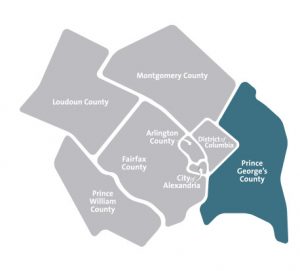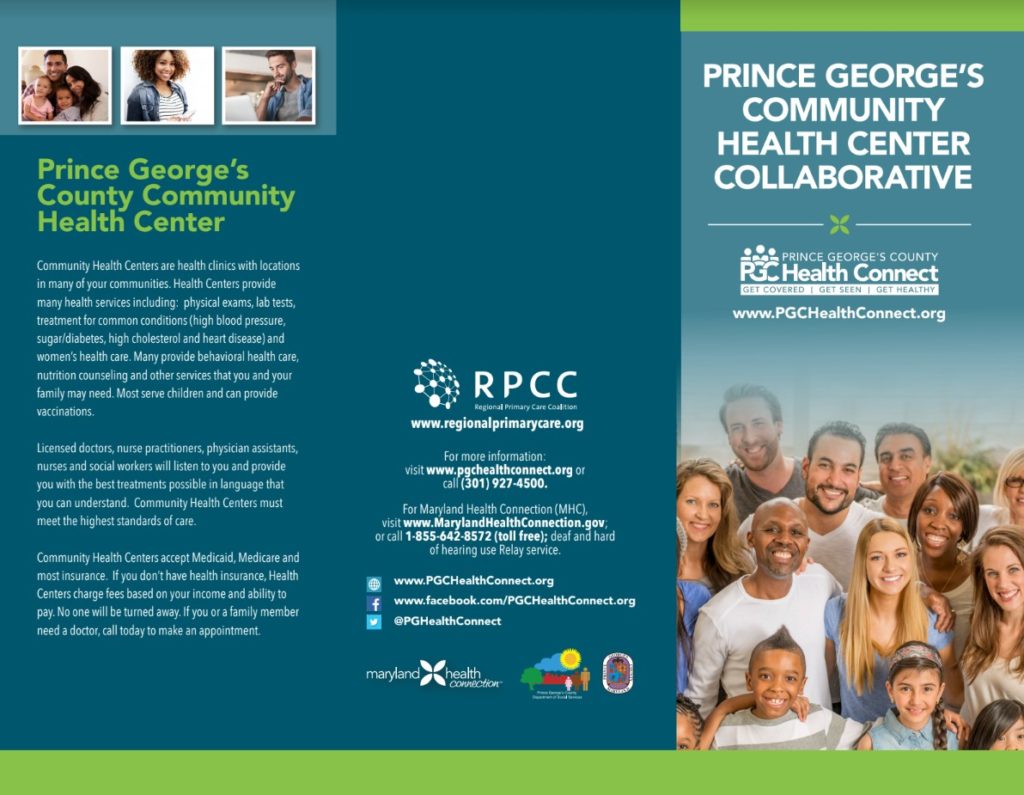Prince George’s County is composed of 499 square miles that borders Howard County to the north; Montgomery County, Washington, D.C. and Fairfax County, Virginia to the west; Charles County to the South and Calvert and Ann Arundel County to the east. It is located 37 miles south of the City of Baltimore. With more than 900,000 residents, it is the second most populous county in Maryland. The County includes rural, suburban, and urban areas, with the area boarding the District of Columbia as the most densely populated.

Prince George’s County

Prince George’s County is a racially, ethnically and economically diverse region. According to the U.S. Census Bureau, in 2016 62.6% of its residents identified as Black alone, not Hispanic; 16.7% as Hispanic or Latino (of any race); 13.6% as White alone, not Hispanic; and 4.2% as Asian alone, not Hispanic. Compared to the state of Maryland, Prince George’s County has twice as many black and Hispanic residents, and one-fourth as many white residents. The median household income in 2016 was $78,700, which is about equal to the state median of $78,800; and the unemployment rate of 8.0% is slightly higher than the state rate of 6.7%. 9.7% of residents live in poverty and 63% of all school age children are eligible for free and reduced-price meals (FARMS), compared to 9.9% and 45% statewide.
Demographics of Prince George’s County vs Maryland
According to the 2018 Community Health Rankings and Roadmaps project, Prince George’s County ranks 14th of 24 Maryland counties based on health factors and outcomes. The average life expectancy in Prince George’s County is 80 years of age, which is slightly higher than the state life expectancy of 79.8 years. The infant mortality rate in Prince George’s County is 7.6 per 1,000 live births; higher than the state rate of 6.5 per 1,000 live births. Also elevated in Prince George’s County is the mortality rate of children between the ages of 0 and 17, at 70.9 deaths per 100,000 children, compared to Maryland’s 52.1 deaths per 100,000 children. In this age group, Prince George’s County has a 1.5 times larger death rate due to conditions originating in the perinatal period, and congenital abnormalities. It also has a 1.8 times larger death rate due to homicide.
Death Rates for Leading Causes of Death in Children Ages 0-17
Heart disease is the leading cause of death among Prince George’s County residents. Chronic conditions including heart disease, cancer, and diabetes account for 60% of deaths. 11.1% of adult residents have been diagnosed with diabetes, compared to 10.2% in Maryland. The HIV prevalence rate in the county is 962.6 cases per 100,000 people, compared to Maryland’s prevalence rate of 632.8 cases per 100,000 people.
Infant Mortality Rate by Race
High Blood Pressure Hospitalization Rate by Race
Heart Disease Hospitalization Rate by Race
Although health indicators assist in understanding the health of a particular population, they do not tell the whole story. For example, infant mortality rates are notably different by race, with higher mortality rates of 6.1 deaths for every 1,000 Hispanic births and 9.7 deaths for every 1,000 black births. Both of these rates increased significantly between 2015 and 2016. Infant mortality rates for white births in Prince George’s County were not reported in 2016 due to statistical unreliability. Other measures of health tell similar stories of inequity when broken down by race. Amongst Medicare beneficiaries 65+, black residents have an increased rate of hospitalization due to high blood pressure, compared to their white or Hispanic neighbors; while Hispanic residents have a much lower rate of hospitalization due to heart disease.
Within Prince George’s County, there are significant disparities in health amongst people of different races, ethnicities, and incomes. These differences can be partially attributed to social determinants of health, which, according to the World Health Organization, are the conditions in which people are born, grow, work, live, and age.
Since the implementation of the Affordable Care Act (ACA), access to health coverage is improving across the county. In Prince George’s County, the number of people without health care coverage decreased from 14% to 10%. However, access to care may continue to be a challenge due to the limited supply of primary care providers practicing within the County. In Prince George’s County, there is one primary care provider for every 1,910 residents, compared to the statewide average of one primary care provider for every 1,140 Maryland residents. Currently there are three regional health systems and five hospitals located in the county. As of 2018, there are six Federally Qualified Health Centers (FQHCs) operating eleven facilities in Prince George’s County. The 2015 Prince George’s County Primary Healthcare Strategic Plan addresses the need to strengthen the county’s primary health care infrastructure, increase access to quality primary care services, and address health care services for uninsured residents. Plans are underway to develop a regional academic health center to replace the Prince George’s County Hospital.
Making Prince George’s County a healthier place for all to live requires not only expanding wellness initiatives and access to quality healthcare, but also addressing the economic and social well being of its citizens.
To see the data sources used for the information above about Prince George’s County, click the purple tab on the right side of this page.
For more information on Prince George’s County, check out the reports and resources below.
The Healthcare Landscape in Prince George's County
In 2018, RPCC worked with five of the Federally Qualified Health Centers located in Prince George’s County to develop a report entitled The Healthcare Landscape in Prince George’s County: Opportunities for Improvement. Access this report to view:
- A detailed view of health indicators, demographics, and health services available in the County;
- Information about FQHCs in the County, including services provided and patient demographics; and
- Models of how Prince George’s County can expand access to care for its uninsured population.
Achieving Health Equity in Prince George's County
On June 7, 2018, the Prince George’s Healthcare Action Coalition and the Prince George’s County Health Department (PGCHD) hosted a one-day meeting, Transformative Change – Our Role in Achieving Health Equity for Prince George’s County, to engage County elected officials, agency leadership, health provider organizations, and academic partners in a conversation about how policies and plans affect health equity. A second meeting of this kind was held November 29, 2018 with the same purpose of convening stakeholders in conversation on health equity. Each of these meetings aimed to build a common language, shared framework, and policy agenda to identify changes needed to integrate Health in All Policies (HiAP), with an intentional focus on equity and inclusion. Both of the reports (see below) from each day capture the essence of the conversations that transpired on that day and document the first steps towards building a health equity roadmap for Prince George’s County.
Prince George's Community Health Center Collaborative Brochure
Get Covered! Get Care! There are six community health centers in Prince George’s County. Community Health Centers are health clinics that must meet the highest standards of care. Health Centers provide many health services including: physical exams, lab tests, treatment for common conditions (high blood pressure, sugar/diabetes, high cholesterol and heart disease) and women’s health care. Many provide behavioral health care, nutrition counseling and other services that you and your family may need. Most serve children and can provide vaccinations. Health Centers in the County accept Medicaid, Medicare and most insurance. No one will be turned away; If a patient does not have health insurance, Health Centers charge fees based on income and ability to pay.
Check out and share the Prince George’s County Community Health Center Collaborative Brochure. This brochure provides details on each of the six Community Health Centers in the County, including locations, hours of operations, and contact information.





